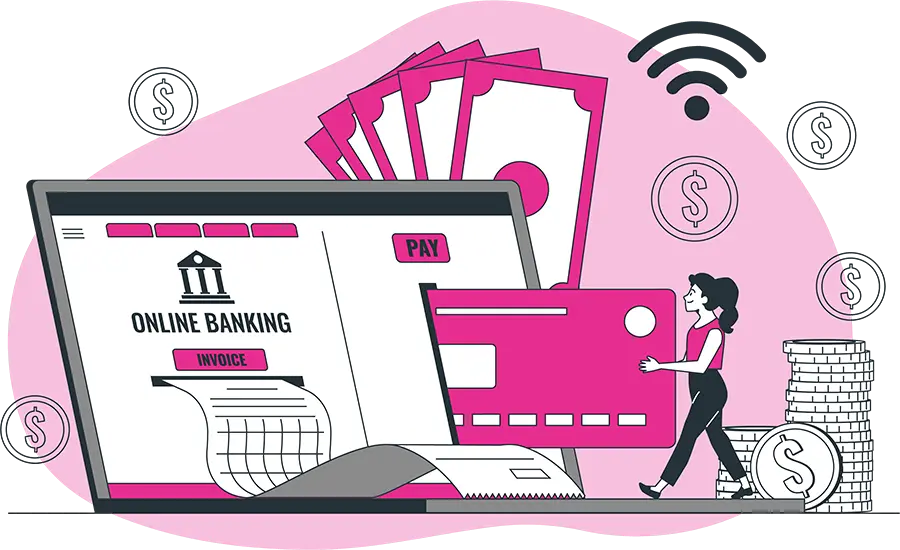Following the coronavirus outbreak in 2020, online shopping seemed to grow exponentially, showing no signs of slowing down.
There’s a clear shift in consumer preferences toward the convenience and choices e-commerce businesses offer. As consumer behavior keeps evolving, many businesses are adopting this model. Moreover, aspiring entrepreneurs are also on the way to starting an e-commerce business.
In all these hustles a question arises “How do E-commerce make money?”We are going to answer this question and also provide you with practical tips to help your e-commerce business thrive in this booming market.
Table of Contents
ToggleSummary of 7 E-com Business Models & How They Make Money
| Business Model | Description | Revenue Source | Profit margin |
| Dropshipping | Sells products online but doesn’t hold any inventory | Earns a commission on each sale | Depending on the business model, niche, and products sold, this range can fluctuate anywhere from 10% to 30% or even up to 30-40% in some cases |
| Print on Demand | Sells custom-designed products printed on demand | Earns a markup on the sale of products | On average, however, you could expect a profit margin of around 20% to 30%, but it could be higher or lower |
| Selling Handmade Products | Sells handcrafted goods online | Earns a profit from the sale of products | Most businesses aim for a profit margin of around 8-30%. Some even recommend a retail conversion that allows artists to make at least a 50% profit margin |
| Selling Digital Products | Sells digital products (ebooks, courses, software) | Earns a profit from the sale of products | Profit margins as high as 85%. This is because once a digital product has been created, it can be sold an infinite number of times without incurring additional production costs |
| Subscription Boxes | Sells curated boxes of products regularly to customers | Earns a subscription fee from customers | Most businesses aim for a profit margin of around 30% to 70%. The average profit margin reported is between 40-60% |
| Affiliate Marketing | Promotes other brands’ products, earns commission | Earns a commission on sales referred through affiliate links | Ahrefs reports that most affiliates tend to earn in the range of 5-10% |
| Selling on Third-party Platforms | Sells products on marketplaces like Amazon or eBay | Pays a platform fee and earns a commission on sales | Most retailers aim for a profit margin of around 20% to 50% after all costs are factored in |
How Do E-commerce Make Money – 7 Incredible Methods
Making money in E-commerce businesses requires a strategic approach. We have prepared a list of some of the most effective E-Commerce business strategies to help you bloom.
1. Dropshipping
It is the easiest way to start e-commerce without the headache of managing inventory and shipments.
This model offers a fast and low-risk way to start an online business. Here’s the core idea:
- You list products on your online store, but you don’t hold any inventory yourself.
- When a customer orders your product, you forward it to your dropshipping supplier.
- The supplier handles the product’s purchasing, packaging, and shipping directly to your customer.
- You, the entrepreneur, handle everything else – marketing, website development, customer service, etc.
Is it the right time to do dropshipping? Google Trends seems to think so. Searches for “drop shipping” have shown mostly an upward trend in recent months, indicating a growing interest in this model.
Here’s how it works
- Find a dropshipping supplier: Choose a supplier offering products you want to sell that offers quality and reliable service.
- Pay dropshipping fees: Expect per-item fees (usually $2-$5) on top of product and shipping costs.
- Set your profit margin: Add a markup to cover costs and generate profit. Keep in mind the competition and keep prices realistic. Also, explore our guide on e-commerce profit margins.
Things to remember
- Dropshipping margins are generally lower than other models.
- Always offer competitive prices and excellent customer service to stand out.
- Thoroughly research suppliers and choose reliable partners for a smooth experience.
2. Print on Demand
The print-on-demand (POD) market value is USD 4.90 billion in 2021 and a projected CAGR is 26.1% by 2030. One key benefit of this flow is its low overhead cost compared to other methods.
But what is POD, and how does it operate?
Like drop shipping, POD eliminates the need for inventory management and shipping yourself. A third-party partner handles these aspects, giving you the leverage to focus on design and marketing.
However, unlike drop shipping, POD offers a major advantage: customization.
You can personalize white-label products with your designs and market them under your brand name.
Here’s how it works
- Design and brand: Create designs and build your brand identity.
- Partner with a POD company: Choose a well-known POD provider that offers products aligned with your target audience.
- Upload your designs: Integrate your designs with the POD platform.
- Customer orders: When a customer purchases a product, your design is printed on demand (hence the name!).
- Fulfillment and shipping: The POD Company handles printing, packaging, and shipping directly to the customer.
3. Selling Handmade Products
Handcrafted goods are surging in popularity, fuelled in part by consumers’ desire for unique and authentic items.
And with online stores making it simple and inexpensive to launch, this “do-it-from-home” business is more tempting than ever before.
Don’t forget! The key to success lies in creating products that resonate with your target audience.
To help you excel on this journey, here are some trending handmade goods for 2024, that we compile for you:
- Handmade Jewelry
- Aromatherapy Candles
- Resin Art
- Punch Needle Embroidery
- Squeegee Painting
- Homemade clothes
- Kitchen & Home Décor
Things to Remember
- Find your niche: Select a defined group to target and deliver your goods according to its needs and interests.
- Focus on quality: Set yourself apart from the competition with high-quality products and a top-notch production technique.
- Present your story: Storytelling is one of the best methods to apply when talking about your creations to get deeper inside the customers’ minds.
- Embrace online tools: Use websites such as Etsy, and all your social media networks to promote and sell your custom gifts handcrafted.
4. Selling Digital Goods
Offering digital products on the Internet promises to be a new and promising path for entrepreneurs!
These include e-books, and designs in graphics formats such as GIFs and JPEGs, among many other materials that can be freely downloaded over the internet not forgetting onsite software services.
But what makes digital products glow?
- Automated: Digital products are instant and automated, so there is no need for time or money.
- Reduced Inventory Costs: Farewell to storage and physical products! Digital products are purely online, and you do not have to worry about managing inventory burdens.
- High Profit Margins: Once produced, digital products have virtually zero production costs which gives you the chance to sell them at higher profit margins than physical commodities.
- Automation Potential: Use technology like automation of delivery and processes, which will enable your business or industry to flow without any manual effort
Here is how you can do it
- Expert Knowledge, Digitalized: Use your knowledge to create profitable digital products such as e-books, online courses, or webinars.
• Digital Assets Galore: Apply your creative talent and sell stock photos, music, videos, or software templates—issuing the licenses to use them.
• Recurring Revenue Streams: Consider subscription models that offer premium content and provide a steady stream of revenue.
Things to Remember
The key is to find your niche and satisfy it according to its needs. The right way to have a good business investment in digital products is a platform that can propel one into a scalable and advantageous venture.
5. Subscription Boxes
To find ways to enhance customer retention, e-commerce firms have considered subscription boxes as a potent weapon.
This strategy is tailored for shoppers who prioritize speed and affordability. They are designed to meet the increasing demand of consumers who need fast and cheap online shopping.
Primarily, subscription boxes refer to the shipment of inventoried product kits that are curated for customers regularly.
Even though it is competitive, finding your niche based on your skills and passion can make you a leader.
Here are some of the hottest subscription box trends experiencing significant growth
- Beauty.
- Food.
- Shaving supplies
- Pets.
- Coffee
- Clothing
Things to Remember
- Niche is key: Identify a specific audience and tailor your box to their unique needs and interests.
- Quality matters: Partner with reliable suppliers to ensure premium products and positive customer experience.
- Curate with care: Select products that offer variety, surprise, and value to entice subscribers.
- Personalize when possible: Cater to individual preferences whenever possible to cultivate loyalty.
6. Affiliate Marketing
Affiliate marketing is an amazing way to make some money from your website without managing inventories, or even creating products.
Use your website, blog, or social media channels to promote other brands’ products and services in return for commissions.
How it Works
- Join an affiliate program: Work alongside brands that appeal to your audience and their areas of interest.
- Promote their products: Incorporate affiliate links into the content that you write, whether it’s a product review, tutorial, or blog.
- Drive traffic and sales: You receive a commission when someone visits your affiliate link and makes a purchase.
Commission Structure
- Percentage of profit: You will receive a percentage of the merchant’s profit for every sale that comes through your link.
- Fixed amount: Receive a fixed fee for every purchase that qualifies.
Factors Affecting Affiliate Commission
- Affiliate program: Each program provides different compensation amounts and payment plans.
• Product category: High-value products will typically generate high commissions.
• Conversion rate: The click-through rate is a measure of how many visitors click your link and purchase products.
Things to Remember
- Build trust: Promote only those products that are relevant to your target customers.
- Transparency matters: Reveal affiliate connections transparently to save the trust of the audience.
- Content is king: Produce quality content that will attract your audience and be blanketed by product endorsements. You can hire SEO experts to boost your content visibility.
- Track and analyze: Track your results to know what works best and perfect your efforts.
7. Sell on Third-Party E-Commerce Platforms
Beginning an online store can sometimes seem like drowning in a sea of endless tasks– creating a website, finding products, and marketing it.
Third-party eCommerce marketplaces such as Amazon, Alibaba, eBay, Etsy, and Walmart provide a straightforward route to establishing your business.
But what makes this method glow?
- No hustle of Website creation: No need to spend time and cash creating your online shop. Marketplaces are premade platforms that offer exposure to your products for millions of potential clients.
- Streamlined Operations: Forget about the payments management, orders, shipments, and tracking deliveries. These platforms take care of those important things you do not have to deal with, such as product selection and marketing.
- Marketing Powerhouse: Using the marketplace’s marketing know-how, and its powerful tools as well as a massive customer audience. This may increase your exposure as well as the potential of making sales by a substantial margin.
- Win-Win Collaboration: You pay a nominal hosting and sales management fee, while marketplaces connect with an audience actively looking for products.
Things to remember
- Choose the right platform: Choose your preferred marketplace that best suits the target group and product focus
- Optimize your listings: To get buyers for a product, excellent descriptions of the product, superior quality images, and prices that your competitors offer make it better.
- Stay compliant: Different marketplaces have their own rules and regulations. However, you should always follow them to ensure no problems.
- Build your brand: Don’t forget that while interacting through the marketplace, you should also focus on creating your brand identity to attract more respondents.
9 Steps to Start E-Commerce Businesses
Starting an eCommerce business can be fun and profitable, but it must be properly planned before being set into motion.
Step 1. Find Your Niche
- Research and find an opportunity in the product category that interests you but is profitable, and rational considering your skills and resources.
• Research the elements of competition, market/captive, and new product development.
Step 2. Develop Your Business Plan
- To your definition, refine who exactly is your target audience, what they will end up benefiting from you, and how you differ factually from the alternative product or service makers.
- Decide on your price positioning, your marketing strategies, and the operations of the business, including production.
- Prepare financial budgets to include estimates of start-up costs, and ongoing expenses with a forecasted return on the capital and revenues.
Step 3. Choose Your Business Structure
- Explore the pros and cons of sole proprietorships, partnerships, and LLCs to find the perfect fit for your business ambitions.
- Check with an accountant or lawyer for the most suitable organizational structure.
Step 4. Establish Your Legal and Financial Foundation
- Obtain necessary licenses and permits for your business and product category.
- Open a business bank account to separate business and personal finances.
- Register for sales tax if applicable.
Step 5. Create Your Online Store
- Select an online buying and selling platform that may be Shopify, Wix, or WooCommerce.
- Create a website that you will be proud of with the help of an easy-to-navigate and attractive website that represents your brand.
- Manage SEO for your product listings while offering superior-quality images and descriptions of the products on the listing.
Step 6. Source Your Products
- Decide the mode of operation you will engage in whether it is manufacturing, dropshipping, or wholesaling your products.
- Join hands with trustworthy suppliers willing to provide cheap rates and quality products.
Step 7. Implement Marketing Strategies
- Utilize social media marketing, SEO, email marketing, and paid advertising to make contact with your target audience.
• Use promotions and discounts to draw new customers and maintain returning clients. For more details read out 9 result-oriented e-commerce marketing strategies.
Step 8. Ensure Smooth Fulfillment and Customer Service
- Work closely with a reputable shipping company to ensure timely and effective delivery.
- Provide return and exchange policies.
- Offer responsive customer service to establish trust and a positive brand image.
Step 9. Analyze and Adapt
- Monitor your site’s traffic, sales figures, and customer comments.
• Assess yourself and identify your weaknesses.
• Be flexible and experiment with marketing tactics and optimization solutions.
How Can I Make More Money on My E-Commerce Site?
E-commerce presents huge possibilities, but one must be proactive to get the best out of these opportunities.
Website Optimization
- Prioritize Site Speed: Fast loading times to avoid customers leaving their carts, frustrated.
• Effortless Navigation: Come up with an easy-to-use layout to create the best experience in the product discovery process.
• Compelling Product Presentation: Spend money on quality images, detailed descriptions, and compelling CTAs to facilitate conversions.
• Upselling Opportunities: At the checkout strategically recommend products that would go well with their purchase to establish better average order value.
• Seamless Checkout: Make it easy for the checkouts so that they have a hassle-free method of purchasing. Use security badges to establish trust
SEO Powerhouse
- Targeted Keyword Research: Know what your target customers are looking for to guide your content design.
- Content Optimization: Insert relevant keywords into your landing pages, product descriptions, and blog posts.
- Technical SEO: Make sure that the structure of your sitemap is correct, that it is mobile friendly, and quickly loads.
- Link Building: Get backlinks from reliable sources to build credibility for your website.
- Engaging Blog: Use valuable content for your niche to set up thought leadership and drive organic traffic.
- On-Site SEO: Improve the user experience by having good navigation, fast load times, and mobile-friendliness.
Ready to boost your e-commerce success? Explore our SEO services!
Product Expansion
- Targeted Additions: Take it further than just grabbing any old products; look for others that address issues or fill needs among your market.
- Customer Insights: Analyze customer feedback, reviews, and purchase history to find possible product gaps.
- Complementary Offerings: Include additional items that can be paired with your current offerings, such as shoe care for shoes or warranties on electronics.
- Variations and Options: Introduce variations of bestsellers with different colors, dimensions, or designs.
- Improved User Experience: A wider variety of products should not affect navigation; make sure that your site is easy to navigate.
Leveraging Tools
- Identify Needs: List your problems and identify research tools to solve them effectively.
- Essential Tools: Look at website builders, eCommerce platforms, data management software, and file hosting providers.
- Shopping Cart Optimization: Discover tools that help to increase conversions and improve the shopping experience.
- Additional Support: SEO, CRM, CRO, and Inventory Management Tools for site design, customer loyalty programs, and PIM.
Retargeting & Remarketing Strategies
- Recapture Website Visitors: Reach out to people who visited your site but did not buy and remind them of what they wanted.
- Re-engage past Customers: Use email and SMS marketing to remind former buyers of your brand and motivate them to repurchase.
- Cost-Effective Approach: Remarketing via email and SMS is very effective not only to increase sales but also to improve the lifetime of your existing customers.
5 E-commerce Business Models to Make Money
While revenue models focus on how your business makes money, a business model encompasses everything involved in your operation, regardless of whether you operate:
- B2C: Businesses selling directly to consumers.
- B2B: Businesses selling to other businesses.
- C2C: Platforms enabling individuals to buy and sell from each other.
- C2B: Individuals selling services to businesses.
Here’s a breakdown of the five most common e-commerce business models:
1. Manufacturer
- They produce goods, either raw materials or simply assembled parts.
- It can sell both directly to the end user and through distributors.
- They are likely to provide private labeling. This is marketing a brand where retailers may give their products different names.
2. Distributor
- Buys products from manufacturers and sells them to wholesalers or retailers.
• Actively markets products and seeks new customers for manufacturers.
3. Wholesaler
- Buys products in great quantities from distributors or manufacturers at a lower price.
• Dropshipping or the third-party fulfillment business model has been a common method of wholesaling wherein retailers transfer orders to other suppliers for delivery.
4. Retailer
- Buying products from wholesalers or distributors and selling them to retailers.
• It may also be a manufacturer who manufactures and sells its products.
• They can use white labeling to buy generic products and brand them as their own.
5. Franchise
- An entrepreneur purchases the opportunity to sell a product or service under the protection of the franchise’s label.
• Franchisees replicate the franchise’s business plan and may act as manufacturers, distributors, wholesalers, or retailers.
Also explore, How long an e-commerce business takes to generate income.
How Do E-Commerce Make Money: FAQs
How does e-commerce Make a Profit?
E-commerce only makes a profit when you source products at a cheap price.
What type of e-commerce makes the most money?
Following are the types of E-commerce that help you make the most money.
- Dropshipping
- Print on Demand
- Selling Handmade Products
- Digital Goods
- Subscription Boxes
The Final Thought
I hope you got the answer to “How do e-commerce make money” as I have shared the top strategies for e-commerce success, from drop shipping to digital goods, alongside 5 business models to consider.
Succeeding in e-commerce can be hard work, which is what 90% of all new e-commerce stores find out 6 months into their ventures.
Fortunately, we have given you enough information to keep you going. Every model in this post is working well right now; it’s just a matter of which one resonates with your passion, skills, and resources.
As with anything in e-commerce, these are not set-and-forget strategies. Always look to your customers and learn from them. Adapt, succeed!









